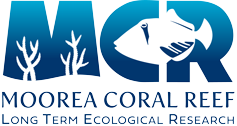First Year:
2012
Last Year:
2013
Data in support of Lenz & Edmunds, JEMBE 2017. [doi:10.1016/j.jembe.2016.10.002] This study tested the hypothesis that intraspecific morphological plasticity within a scleractinian coral elicits differential responses to elevated PCO2 and temperature. In Mo'orea, French Polynesia, two short-term laboratory experiments (21 and 14 days) were conducted to test the effects of PCO2 (400 vs. 700 µatm), and PCO2 (400 vs 1000 µatm) combined with temperature (27.0 vs. 29.8 C), on branches and plates of Porites rus. Experiments employed two irradiances (~1000 vs 200 µmol photons m-2 s-1), which characterized the microenvironments on the shallow fringing reefs where branching and plating morphologies are common, respectively. Calcification of both morphologies was insensitive to PCO2, as well as the combined effects of elevated PCO2 and temperature. Mean calcification rates were faster in high light than in low light for both morphologies, and biomass was greater in plates than branches in all treatments. Together, our results suggest P. rus is robust to increased PCO2 and high temperature within the constraints of the treatments applied. Morphological plasticity in this species does not mediate physiological resistance to low pH and high temperature.
This material is based upon work supported by the U.S. National Science Foundation under Grant No. OCE 16-37396 (and earlier awards) as well as a generous gift from the Gordon and Betty Moore Foundation. Research was completed under permits issued by the French Polynesian Government (Délégation à la Recherche) and the Haut-commissariat de la République en Polynésie Francaise (DTRT) (Protocole d'Accueil 2005-2020). This work represents a contribution of the Moorea Coral Reef (MCR) LTER Site.
Package Type:
Publication
Topic:
Coral
Core Research Areas:
Populations
Keywords:
Scleractinia, Porites rus, Marine Environments, Shallow Water, Ocean Acidification, Reef Resistance and Resilience



